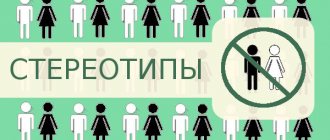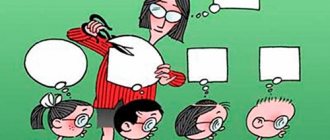Adviсe
- What is a stereotype?
- What are the stereotypes?
- Gender stereotypes: women and men
- Children
- Happiness
- "Correct"...
- What are professional stereotypes: examples
We will talk about stereotypes - norms, canons, laws, customs, traditions, prejudices of society. Most people think they are correct and follow them. Here it is important to distinguish between the concept of the correctness of a stereotype and convention (far-fetchedness). But fictitious stereotypes sometimes control the collective consciousness (including us). Stereotypes of people are primarily divided into global - characteristic of the scale of the planet, and narrow - those that we follow in schools, at work, at home, etc. However, both of them become an illusion that has a lot of followers.
Male models are traditionally classified as gay
What is a stereotype in simple words
A stereotype is a generally accepted image of a person, phenomenon or event. The term was coined by American journalist Walter Lippmann in the 1920s.
He borrowed this word from printers. People in this profession use the word "stereotype" to refer to a printed form that allows text to be reproduced over and over again.
Walter Lippman identified several properties of stereotypes
- they make life easier;
- they are often wrong;
- they are not produced by the person himself, but are acquired from the outside;
- they are extremely stable.
The word “stereotype” itself is translated from Greek as “strong imprint.” It is a specific way of thinking that helps create certain images of events, and can also prevent a person from looking at the world from a broader perspective.
Where do stereotypes come from?
Stereotypes existed in the thinking of our ancestors long before civilization. For example, primitive man knew that his big, muscular friend was dangerous because he could rob him of his food, clothing, or woman. This primitive stereotype is still alive today, tens of thousands of years later, whenever a stranger of the same appearance encounters it.
The early humans' tendency to be wary of strangers was justified. The good-natured and naive quickly died, so we are all descendants of those who fought against strangers. Even today, many people are afraid of everyone who looks different from us: who has a different complexion, who has dyed their hair a different color or who dares to get a tattoo. Different means dangerous! And the older you get, the more wary you become of people who seem strange to you.
The dangers of stereotypical thinking
Stereotypes are considered “laziness of the brain.” Why think for yourself if others have been thinking for you for a long time. Why waste energy on an objective analysis of people's behavior if society has decided that one thing is good and the other is bad.
In the 21st century, when not only technology, but also people’s thinking is developing, stereotypes create more and more problems in the perception of the world and narrow horizons.
The more stereotypes a person has, the less educated he is and the more susceptible to manipulation by other people. Such people are called “winged”.
Many create stereotypes intentionally for their own reasons to influence society. In this way the masses can be controlled and forced to organize themselves as the creator of the stereotype wishes.
Nowadays, everyone should have their own opinion about any situation, everyone should be able to think independently and objectively assess what is happening. Expressing your views and speaking about them correctly is an important part of personal development. However, some stereotypes are necessary, as you will learn in the next chapter.
Most stereotypes are based on moral old ideas about life
What is the difference between a stereotype and prejudices and clichés?
Prejudice is a flexible concept that can change depending on specific circumstances. Bias can be identified, addressed and corrected, and changes throughout life. Prejudices arise both on the basis of a stable perception of something and as a result of momentary emotions. Thus, prejudice can arise from a stereotype.
The main difference is that a stereotype is practically irreversible, whereas a prejudice is easily formed in the mind and can just as easily be canceled or changed. In addition, the word "prejudice" has a narrower application compared to stereotype. It is used only to characterize the way people think or perceive something. It does not describe any social event or phenomenon.
Cliché is another term from the science of human behavior and typography. This is closer to a stereotype than a prejudice. In general, the term "cliché" means a standard, a pattern, a fixed, unchanging form of something. This applies to various areas - human speech, the arrangement of printed texts, the way makeup is applied, art, and so on. Even in the image of politicians there is a certain cliché. This is the difference between the term and the concept of cliché. A cliché is an unchanging form of something that can become a template for action. For example, templates for filling out forms are also clichés. Stereotype, on the other hand, has no such meaning.
How they change and what it depends on
Stereotypical behavior changes its vector over time. What was previously unacceptable has now become commonplace. This can be observed in changes in people's attitudes towards the institution of marriage.
The change in women's role models is also noticeable. Now she can climb the career ladder on an equal basis with men, occupying positions that were previously considered exclusively male.
What is the original meaning?
Most people are accustomed to attributing the concept of “stereotype” to sociology, psychology and other scientific fields, the subject of which is the behavior, thinking or character of a person. In colloquial speech it sounds precisely in this context. Meanwhile, initially the word had nothing to do with describing a way of thinking, the characteristics of individual people or society as a whole.
Initially, “stereotype” was the name of a piece of equipment intended for printing. This is the name of a form that is a monolith and is an actual copy from a ready-made printing set or a separate cliche. This form is fully functional and is intended for use in printing machines.
Why are stereotypes needed and how are they used?
Stereotypical thinking is inherent in every person. It was not given to us just like that. Stereotypes help save mental effort and time by helping us make quick decisions in repetitive situations.
For example, historically the division into enemies and friends was necessary. Stereotypes contributed to the automatic perception of strangers as a source of threat. This function is often in demand today.
Think about what you do when you wake up. You probably have a certain set of actions that you perform on autopilot. During this time, your brain adjusts to your daily routine - this is much more important than thinking about every step. Or, for example, when you enter a room, you see a table and a chair. You don't have to think about why you need them, you already know how to use them.
Did you know that Albert Einstein had five identical sets of clothes in his wardrobe for every day? The great physicist completed such a set so as not to waste time in the morning choosing an outfit.
The time and energy saved can be redirected to more important tasks. Mark Zuckerberg recently resorted to such tricks.
Stereotypes help free up mental resources for thinking about other thoughts and performing primitive sorting of information. Stereotypes also help us understand how to dress and behave depending on the situation and place.
Are there similar concepts?
The words closest in meaning to the concept of “stereotype” are “cliché” and “prejudice”. Often, during conversations, people refer to all three concepts, giving them exactly the same meaning.
The terms are indeed similar in meaning, although not completely identical. Therefore, before using them interchangeably, you need to have a general understanding of the differences in meaning.
Also close in meaning to the concept of “stereotype” are such phenomena as traditions, cultural customs, and various social concepts.
Types of stereotypes
Stereotypes can be: negative, positive, neutral, overly simplified, approximate, overgeneralized, accurate. Psychology distinguishes these types.
Ethnostereotypes
Stereotypical ideas about yourself or other people. Most often it destroys positive communication between people, which leads to negative consequences. When prejudice becomes the norm, it forms the basis for discrimination, extreme nationalism, terrorism and racism. Everyone has typical stereotypes about a resident of another state.
In the eyes of the majority:
- Typical Chinese: short, talkative, loves rice;
- Typical American: self-confident, smiling, loves hamburgers;
- Typical Frenchman: dude, lover of romance, gourmet;
- Typical Englishman: primitive, loves porridge, reserved.
Similar stereotypes exist everywhere. We laugh at jokes about Armenian radio, Chukchi, crests, Muscovites. We joke about the slowness of Estonians, the greed of Jews. Jokes based on stereotypes may be offensive to some, but they do not pose a serious threat. However, ethnic stereotypes can be compared to blindfolds that narrow our horizons and harm us. They prevent you from appreciating the culture of another country, making good foreign friends, etc.
Gender
They represent preconceived notions about men and women. These superstitions have existed for centuries and have their origins in the hunting of men and women as guardians of the home. Ancient myths and ballads are also present. In the modern world, gender roles have undergone many changes, but stereotypes are firmly rooted in the minds of the majority. The most common of them are: “Men don’t cry”, “A woman’s place is in the kitchen” and so on. Many of us adhere to this way of thinking.
Individual
Refers to the individual personality. Refers to the opinion of an individual, which may coincide to some extent with social stereotypes or completely contradict them. They are formed at the individual—personal level. They are also called socio-psychological.
Social
Refers to a group of people. Help us shape our worldview. At the same time, we separate “our” group of people from others. This can be both empowering and depressing. In its simplest sense, a social stereotype is a stable and somewhat simplified idea of a phenomenon, group of people, event, etc. Example: politicians lie constantly, Italians are passionate and emotional, redheads are impulsive.
Social stereotypes are rarely accurate - most often they are false and perform a reactionary function, distorting people's knowledge and causing discord in interpersonal relationships. At the same time, they play a big role in assessing the world.
Associative
Such stereotypes are rarely mentioned. However, the associations formed in the human mind are based almost exclusively on various stereotypes. Associative perception is influenced by customs, traditions and ideas from different areas of life.
For example, if the weather forecast says it will rain, most people dress warmly and don't forget an umbrella. And only a few will think not about an umbrella, but about a mackintosh (raincoat). This is why the vast majority of people associate rain with umbrellas. You can also take an example from the holidays. We associate Christmas with a decorated Christmas tree, gifts, sales, and so on. This is an associative stereotype.
Cultural stereotypes
Cultural stereotypes of society influence human emotions, which are associated with physicality and supported by gestures. Emotions and gestures are a universal language among culturally similar peoples, but in individual countries they can take on completely different meanings. Before traveling to other countries, it is useful to learn about the customs of these countries. Culture unites: stereotypes of purpose, communication, perception, worldview. Stereotypical behavior is an important stage in the formation of (religious) rituals in different cultures.
Behavioral stereotypes
Most people consider these stereotypes to be correct, unchangeable and completely natural. Many people don't even realize they are dealing with a stereotype.
What is a stereotype in human behavior? By definition, this is a specific, fixed system of reactions and behavioral skills characteristic of a certain group of people. Such stereotypes may be due to age, ethnicity, cultural values, social status and other similar factors.
An example of such stereotypes is the behavior of adolescents that accompanies a period of hormonal changes in the body. The so-called “teenage rebellion” is precisely a behavioral stereotype. Another, no less established stereotype is the expected behavior of representatives of “privileged” social classes. Snobbery, selfishness, narcissism and other similar traits are always expected from the so-called “elite”.
Against the backdrop of stereotypes, problems such as homophobia, xenophobia, and gender inequality develop
Is there a general definition?
Stereotype - what does it mean in simple words? Is there a single definition for this term that summarizes all its modern meanings? Of course, there is such a definition, since the understanding of what is called a stereotype in psychology, philosophy and sociology is very similar to each other.
A stereotype in psychology is a stable, often completely or partially untrue, idea of something. The term is given the same meaning by philosophers and sociologists. Of course, there are also narrower, specific definitions related to a specific use of this term.
Pros and cons of stereotypical thinking
People who are accustomed to stereotypical thinking can live full lives and even benefit from this trait. The main advantages of stereotypical thinking include:
- faster decision making;
- less mental fatigue when analyzing information;
- belonging to a particular social group;
- clearing memory of unnecessary information.
At the same time, the tendency to think in stereotypes imposes certain limitations. Its main disadvantages are:
- wrong decisions and wrong actions;
- self-confidence, inability to think critically;
- inability to independently analyze and draw conclusions;
- stereotypical thinking hinders development.
Stereotypical thinking has more disadvantages, so it needs to be combated by developing critical thinking skills and objective analysis of incoming information.
Functions of social groups
American sociologist Neil Joseph Smelser identifies the following functions of social groups:
- Socialization function: only by being a member of a social group is an individual able to survive, start a family and raise children. A person cannot live alone outside of society; he will be doomed.
- Instrumentality function : a person cannot do without work, he must carry out some kind of activity that allows him to provide himself and his family with everything they need.
- An expressive function in which members of a social group must satisfy the need for respect, trust and goodwill towards each other.
- The supporting function, which aims people to unite in groups in difficult situations and determine joint actions.
One way or another, stereotypes formed in social groups with certain functions are not always true and often interfere with living a full life. Therefore, before succumbing to this or that judgment, you should understand yourself and your own concepts.
How to fight stereotypes?
As you know, stereotypes are designed to relieve your brain of unnecessary stress. But they also limit your prospects. To think more broadly, you need to destroy stereotypes, expand the boundaries of awareness and think more creatively.
You shouldn’t blindly believe in what people once came up with. You have to put in the effort, think independently and not be afraid to have your own opinion. If we are constantly confronted with information that contradicts them, they are destroyed.
How to distinguish stereotypical beliefs from conscious beliefs? Just ask yourself: “How do I know this?” If you yourself have had such an experience and are convinced of the correctness of this statement, then this is not a stereotype.
Many stereotypes can be destroyed in just a few minutes. For example, “All blondes are fools.” Scientists have proven that hair color does not affect intelligence. You can name a few blondes you know who don't fit their description.
Or think of celebrities who do not fit the stereotype: Angela Merkel, JK Rowling, Hillary Clinton, Elizabeth Gilbert. The stereotype was destroyed. In everyday life we come across many clichés. As a result, the brain will learn to think more broadly, and most prejudices will disappear on their own.
In some cases, we can say that stereotypes help to live, but more often they interfere with living fully, limiting the activity of thinking and not allowing consciousness to go beyond the templated worldview. An example is the stereotype “It’s good where we are not.” Following it, a person becomes convinced of the impossibility of a comfortable existence in the environment, which leaves an imprint on his condition. In his opinion, all other countries are prosperous and the people living in them are much happier.
Such absurd ideas can quickly become depressing. A person who follows a stereotype does not try to find happiness and harmony, because he is convinced that he will not succeed. And yet you should not blindly follow platitudes you hear accidentally. The aforementioned stereotype of a ghostly wonderful life “where there is no place for us” makes us believe that we have to put in minimal effort to live at a high level. A feeling of envy, irritation and dissatisfaction with one’s own “unsuccessful” life arises.
The main method of combating stereotypes is to question them and analyze them. Don't blindly trust stereotypes, challenge them, check the data, form your own opinion. Gradually, you will get rid of entrenched stereotypes and prevent the formation of new prejudices.
Think about what stereotypes you use every day. Look for ones that have no real evidence to back them up. Example: “All blondes are fools.” When you start digging deeper, you will find that among fair-haired women there are many female doctors, talented doctors, noble teachers and many other individuals who do not fall under the definition of “dumb”.
Look for refutations and other claims that have no basis. An example of a stereotype: “It doesn’t matter what the price is, it doesn’t matter what the product is.” You may be surprised, but here you can find a lot of high-quality and stylish things at low prices. At the same time, expensive purchases can disappoint after the first purchase, raising suspicions of a defect or counterfeit.
A person can follow an absurd stereotype for a long time and not even notice it. Ask yourself, are there such people in your perception? If you can't get rid of them, try meditation. This will teach you to think separately from society and your immediate environment and draw your own conclusions. Try to analyze familiar stereotypes and form your own opinion about them.
Think about the actions you take automatically. Spend some time analyzing them. Try to pay attention to your actions and see which of them are dictated by stereotypes. Learn to be independent of public opinion and develop your own perceptions and imagination.
Stereotypes can and should be fought in modern society
Summary
I think it became clear from the article that stereotypes are more dangerous than useful. I suggest we all carefully consider our own opinion on the main issues of life and determine whether it is really “ours”?
Or maybe this is not ours at all, but “public opinion” imposed on us? And maybe it’s even harmful to us? Maybe it’s enough to hold on to a “stable” job, endure an evil boss and a low salary, and finally decide and get out of your comfort zone and build your own business , create passive income , master financial literacy , start traveling , become a downshifter , lead a life in the slow life , write down your goals and dreams and do many more interesting and useful things. Useful for yourself, not for your employer!
I wish everyone to dream! I wish you inspiration and confidence in your abilities!
Alena Kraeva
SMARTBLOG
What are the stereotypes: examples
Below are some examples of modern stereotypes. If you find this list incomplete, you can add to it by writing your own examples in the comments. Let's start with gender stereotypes.
A woman's place is in the kitchen
Unfortunately, even now, in a developed and equal society, you can very often hear such phrases from men. Some people believe that a woman is a stupid and helpless creature who should cook borscht, wash, clean and remain silent in male society.
This is a historically Eastern model of thinking, but Slavic men often adhere to it, just not so obviously and categorically.
A girl in business is not taken seriously. If a man comes to a business meeting, he is a priori taken more seriously than the fair sex. Everyone forgets that in any business, ambition, responsibility and a sense of duty are important, not gender differences.
A man must!
Since childhood, mothers have been trying to raise real (in their understanding) men, trying to knock out all signs of weakness from the boy, because, after all, “a man must be strong!”
This is inherently correct, but sometimes when there are too many such stereotypes, it can lead to low self-esteem due to the fact that a person does not fit into the invented norms. And after that this will lead to many problems in building relationships with the opposite sex.
How often can you hear the mother of a little boy on the street: “Stop crying, men don’t cry!” From childhood, boys are taught to keep all emotions to themselves, which can lead to serious problems in the future (read more about this in the article on psychosomatics). Tears are a natural process, so everyone cries, regardless of gender and age.
Both men and women have tear glands and ducts that allow us to clear moisture from our eyes. Tears are produced under the influence of certain factors. The difference is that boys are raised somewhat more strictly than girls. From childhood they are taught that they must hide their feelings and emotions, that they have no right to be weak, and so on and so forth.
Why do men die earlier from ulcers, strokes, and heart attacks? Because women are allowed to cry and vent their negative emotions, while it is more difficult for men to do this due to social stereotypes.
Negative emotions never leave the body. They accumulate like a snowball, and one day they will make themselves felt. Therefore, it is necessary to find ways to get rid of negative emotions. Sublimation helps fight negative emotions and internal tension.
Men shouldn't feel pain
Debilitating mental or physical pain should be easily tolerated by men. Any injury is nonsense, a blow below the belt from your best friend - throw him out of your head and forget, breaking up with your girlfriend, divorce - the opportunity to be free and have fun at your own discretion.
In reality: vulnerability to experiences and physical pain is highly individual.
All people have a certain pain threshold, which depends solely on genetics. The level of stress resistance and physical development are also important.
The male body is designed in such a way that, thanks to the high content of testosterone, it can more easily endure physical pain. However, this does not mean that a woman cannot be in better physical shape than a member of the opposite sex. And judging everyone from the same position is, to say the least, unreasonable.
When it comes to mental state, there are no clear criteria. Everyone deals with this differently.
Many stereotypes are directly related to the gender roles that exist in our society
A man must be the breadwinner in the family
This statement is very common. For some reason, it is believed that since the days of hunting mammoths, it is the strong half of humanity that must fully provide for the entire family, returning home from time to time. The rest of the time, the man works hard in his profession, earning a living. The woman, on the other hand, takes care of the kitchen, the house, feeds and gives birth to children.
But what if the couple decided to do the opposite? The woman makes a career, and the man takes care of the house and children. By definition, he is already a pimp. But is this really so?
The reality: masculinity is not determined by salary. Firstly, as we all know, and this has been proven in practice, taking care of a home and children is not so easy, and sometimes much more difficult than working. From this we conclude that all decisions in a couple should be made together and be mutually satisfying, regardless of the division of roles. Secondly, if the wife’s comfort zone is work, her own business, climbing the career ladder, and the man wants to take care of the house and knows how to do it masterfully, and for them this is the only acceptable solution, then why not. The result and the internal atmosphere are important, not stereotypes and generally accepted ideas.
Good children obey their parents
Another stereotype from parent-child relationships that can lead to tragic consequences for the child’s psyche. When parents often tell a child that he is bad because he does not obey, the child’s psyche perceives these words as: “I love you only if you are good.”
A sense of security and unconditional love from parents is important for children's self-esteem. Regardless of behavior. If children are spoiled, do not deprive them of love and do not tell them that children used to be different, young people have become dissolute and in old age there will be no one to bring them a glass of water.
Right wrong
It is considered right to receive a prestigious education at a renowned university. Prestigious professions are usually lawyers or economists. The wrong professions are artists, actors and singers.
From childhood we are taught not to listen to ourselves, not to follow our dreams, but to live “correctly.” But everyone forgets that this very “right” is different for everyone.
The most important thing in life is to do what makes you happy. If a person enjoys his work, he will definitely achieve success in his business. Unfortunately, many people go to work just to earn money, without thinking about their emotional state. This is why so often even the richest people experience crises, depression and constant dissatisfaction with their lives.
If you haven't decided what you want out of life yet, you might want to read about how to find a job that's right for you.
Prejudice in professions
Depending on your personal experience with a particular profession, you may come to certain stereotypes. For example: “police officers are brave, courageous and strong”, “doctors can do anything” or “you are a psychologist, let me read my thoughts.”
These are all stereotypes about professions that have nothing to do with real work. It all depends on the specific person and the situation in which he finds himself, and not on the general idea of the profession.
Age
Teenagers are always in conflict with their parents. Young people are promiscuous and commit immoral acts (adults know better what they should do). At thirty, everyone experiences a midlife crisis. An elderly person should be gloomy and talk only about illness. If he's cheerful, it's best to stay away.
Money
Wealth is real happiness. A person who earns little is a priori unhappy. Every person must persistently strive to climb the career ladder to a high position, otherwise he is a failure. Otherwise he is a failure. Only with a good income can you build a strong family with your loved one. Without money, happiness is impossible.
The most popular stereotypes about Russia
Usually, when people travel abroad, they have in their heads a list of so-called stereotypes about a particular nationality. Over the years of its existence, Russia has accumulated quite a few stereotypes that foreigners attribute to it. Some of them are partially true, others are completely false, and this can be said about any country and its people.
It is very important to understand that not all people are the same size. So it's time to debunk some age-old myths about Russians.
There are many prejudices and stereotypes about Russians in Russia
Most popular name
Ivan is the most popular male name in Russia. It's not even Russian. Rather, it is an East Slavic version of the Hebrew name. Between 2010 and 2021, Ivan was the sixth most common male name. The top three included Alexander, Sergey and Dmitry.
By the way, even Russians often call the name Natasha the most popular female name. However, Natasha is in third place, Elena is in first, and Olga is in second.
Appeal
Russians call each other “comrades.” This word was coined by the Bolsheviks to replace the pre-revolutionary ways of addressing people as “Mr.” and “Madam.” You can address people as “comrades,” but that has long since disappeared from everyday language.
And if you suddenly hear such a speech, then most likely it was said with a touch of irony.
How Russians dress
All Russians wear a hat with ears. Also a military hip belt with buckle. And felt boots with tops. And, of course, the traditional Russian shirt! Russians do not have traditional clothing. Russia consists of many nationalities and cultures, which entails completely different clothes.
Ushanka is still good for winter, but it was quite popular in Soviet times. In those days, the clothing industry belonged to the state, so hats with earflaps were produced according to the state plan. Nowadays, most people prefer regular knitted hats, as a hat with earflaps can get terribly hot at -15°C.
Foreign languages
Russians also understand other Slavic languages, such as Polish, Czech, Ukrainian, Bulgarian, etc. - and say them.
To the Western ear, almost all Slavic languages may sound the same because they come from the same language group. However, there are both similarities and significant differences - especially in vocabulary and grammar.
Many Russians can understand some Ukrainian or Belarusian words, but learning Serbian, Polish or Czech will be a little more difficult for a Russian.
Bears as part of society
Bears walk the streets of Russian cities. A bear or elk that wanders into a remote Russian village is not used to walking along city streets. This is too dangerous for both animals and people.











